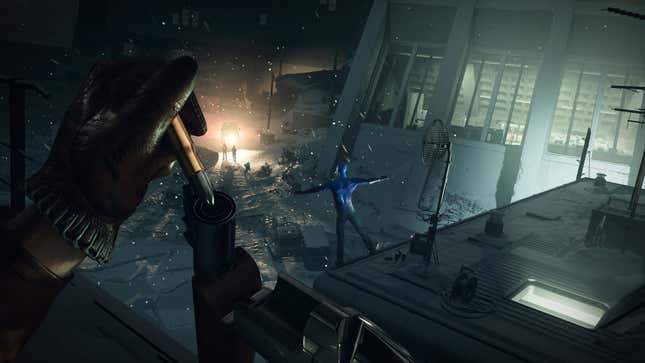
Blackreef is a city built for violence. Every citizen is armed, and every law is overturned. It is a 24 hour party, and sometimes partying involves shooting your friend in the head...I guess. I’ve never been a real party girl.
Deathloop, developed by Arkane Lyon and released a few days ago, is a game about killing eight people. To do this, you time-loop, teleport, and first-person shoot your way across an island filled with colorful weirdos. All of these weirdos suck, and all of them want to kill you. Deathloop is part of the immersive sim tradition, which means the game is built on systems interactions and abilities as much as it is on quality gunplay. And virtually all of those abilities and systems are designed to facilitate one thing: murder, and a lot of it.
This is not unique in video games, though at times it can feel like the vast majority of the medium is built around giving you a lot of tools to hurt people very badly. In fact, nonlethal options are the exception and not the rule in most games. The immersive sim genre, which prioritizes unique character builds, player expressivity, and creative problem solving, however, is different. Deus Ex’s classic and modern incarnations encourage nonlethality as an option. So does the Dishonored series, also by the Deathloop devs. It has become standard fare to give you a gun that kills and shoots fast, and a gun that shoots slowly and does not kill.
There have, of course, been some recent exceptions to this genre tradition. Prey removed nonlethal options for the most part. The game also removed basically all of the people, though. Most of what you fight is some variant of fucked up monster, for whom a nonlethal option does not exist. Deathloop is the first immersive sim in recent memory to center itself around human enemies while completely removing nonlethal options. It is, after all, a game about killing eight people.
In Dishonored, I left most of the game’s tools on the table, because I always choose nonlethal options. No tornados, rat swarms, mines, guns, or even the game’s signature folding sword. That left me with sleep darts, a handful of sleep mines (sometimes), and my own good hands. Of course there were tools for avoidance and traversal, a lot of them actually! These benefit both playstyles. But in terms of volume and efficiency, murder was always easier. It also consistently looked cooler.
Deathloop, meanwhile, encourages players to use all of the murder tools at their disposal. And each of those tools is tuned to feel great. The first long rifle in the game, the Rapier, booms and kicks just right. It’s accurate enough to feel useful, while still having enough shot variation to feel too powerful to be reliable. The LIMP-10, the game’s first machine pistol, spits bullets like a petulant and deadly child until it jams. That jamming feels great! And produces moments of desperate improvisation. It is a wonderful, and effective, piece of shit.

I could not tell you how the Dishonored pistol feels (I’ve heard it’s great), because I basically never used it. I can tell you that Windblast looks cool! But its rhythms and quirks are totally unfamiliar to me. Grenades? No clue. The weird razor mines? Fuck if I know. Half of the series remains totally alien to me, and Dishonored 2 is in my all-time Top 10.
Nonlethality was more difficult in Dishonored, but also narratively encouraged. You are rewarded for not killing people, it is the “Good” option. The city gets worse with every murder. Sicker, more ridden with rats. A city slick with blooded grime. And in the end it tells you as much. You killed a bunch of people, and now the city is worse. Deathloop abandons this central tension, and becomes a bit more frictionless. But it didn’t lose as much as I thought.
This is because Dishonored and Deathloop are built around totally different questions, both narratively and mechanically. Dishonored asks the player, through systems and characters alike, “Can the city of Dunwall be saved, and is it worth saving?” And so, it gives you the tools to answer those questions. Nonlethality and systemic reform can save this place, it argues. Dunwall can be saved, and it hands you the tools to do it. Even Prey, a game which has little interest in nonlethality, has an ending which judges you on whether or not you used the “Good” human tools or the “Bad” alien powers. “Are you human enough it?” It wonders, and then lets the tools you choose answer that question.
Deathloop however, asks you “Why does this place deserve to die?” And then spends its entire narrative answering this question. It is a game about breaking the loop, Colt has already decided this place isn’t worth saving. And so he is given the tools to put that answer into practice. All of its abilities and guns become descriptive of your character, not prescriptive like they are in Prey and Dishonored.
So while this different design choice does remove tension, it doesn’t undercut the game’s narrative like it would in Dishonored. These two games, borne from the same genre, built by the same team, and armed with the same verbs, are answering totally different questions through their design, which highlights Arkane’s near mastery of the genre. Not only did an immersive sim actually get me to use all of the tools at my disposal, it also got them to feel narratively resonant, and that’s worth celebrating, even if I remain a firm Dishonored stan.